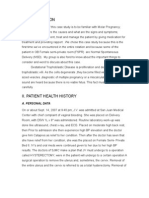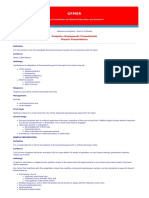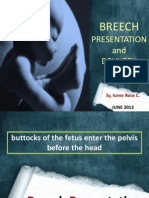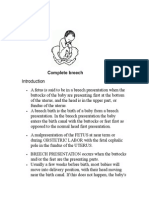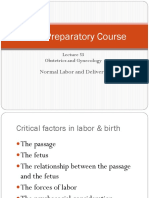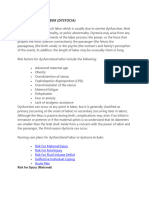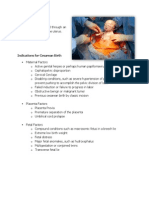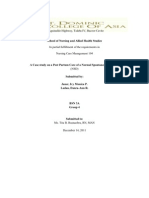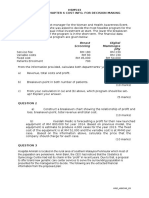Examination of The Gravid Abdomen
Examination of The Gravid Abdomen
Uploaded by
Arvind SeecharanCopyright:
Available Formats
Examination of The Gravid Abdomen
Examination of The Gravid Abdomen
Uploaded by
Arvind SeecharanOriginal Description:
Original Title
Copyright
Available Formats
Share this document
Did you find this document useful?
Is this content inappropriate?
Copyright:
Available Formats
Examination of The Gravid Abdomen
Examination of The Gravid Abdomen
Uploaded by
Arvind SeecharanCopyright:
Available Formats
Authors: James Duffy, Louise Hancock and Gaity Ahmad
Examination of the Pregnant Abdomen
Medical students often find the examination of the pregnant abdomen daunting.
This document provides a framework for you to develop a comprehensive understanding
of the pregnant abdomen examination at undergraduate level.
To assist your learning this is presented as a step-by-step guide, together with questions
to test your understanding.
Introducing Yourself and Gaining Consent
Appropriate Introduction (Full Name and Role)
Hello my name is Alex Middle, I am a final year medical student at Prince Charles Hospital.
Confirm Patient Identity
Can I clarify your name and date of birth please?
Gaining Verbal Consent
Are you comfortable with me feeling your tummy to see how baby is?
Expose the Patient and Wash Hands
Could you lie down on the couch and lift up your top so I can see your tummy while I wash my
hands?
Remember to appropriately expose the patient from the costal margin to the pubis symphysis,
ensure they are lying comfortably and as flat as they can manage.
Ask
Are you comfortable?
Are you experiencing any pain or tenderness?
How many weeks pregnant are you?
Pregnant Abdomen
Inspection
Comment on the presence or absence of the following key observations:
1. Distended abdomen
The abdomen is distended and consistent with pregnancy.
2. Fetal movements
Present from 24 weeks.
3. Scars
Suprapubic Scar: Previous caesarean section, laparotomy for ectopic pregnancy or ovarian
mass removal. Sub-umbilical scar suggests previous laparoscopic procedure.
www.askdoctorclarke.com
Authors: James Duffy, Louise Hancock and Gaity Ahmad
4. Umbilicus
Umbilicus maybe flat within the surface or everted due to increase abdominal pressure. Inversion
of the umbilicus is normal.
5. Cutaneous Signs
Linea nigra: a line of dark pigmentation stretching from below the xiphi sternum through the
umbilicus to the supra pubic area.
Striae gravidarum: Purplish striae of no clinical significance.
Striae albicans: Silvery-white striae indicting previous parity.
Distended superficial veins: indicating alternative paths of venous drainage due to pressure on
the inferior vena cava by gravid uterus.
Palpation: Measuring the Symphysio-fundal Height (SFH)
The uterine size can be measured and expressed as the SFH, it represents the distance between
the fundus of the uterus to the pubis symphysis.
Locating the fundus: Palpate the highest point of the uterus, the fundus, by using the ulnar
border of the left hand and moving it downwards from below the xiphi sternum until the fundus is
located.
Locating the pubis symphysis: Palpate downwards in the midline starting from a few
centimeters above the pubic hair margin.
Measurement: The SFH can be measured by using a tape measured in centimeters face
downwards.
The uterus is palpable from week 12 of gestation and reaches the umbilicus by week 20, at which
time the SFH increases by 1cm per week. The maximum height of the uterus occurs at week 36
where is lies under the ribs. After week 36 the uterus descends due to the decrease in amniotic
fluid volume and the descent of the fetal head.
A higher than expected SFH value can be due to macrosomia, multiple pregnancy and
polyhydramnios.
A lower than expected SFH value can be due to intrauterine growth retardation or
oligohydramnios.
Examination of the Pregnant Abdomen
www.askdoctorclarke.com
Authors: James Duffy, Louise Hancock and Gaity Ahmad
Fetal Lie
Lie of the fetus describes the relationship of the longitudinal axis of the fetus to the longitudinal
axis of the uterus.
Facing the mother, place one hand on each side of the uterus and apply gentle pressure. One
should be able to feel the resistance of the firm fetal back and on the opposite side it maybe
possible to feel the fetal limbs.
Fetal lie can be described as longitudinal, transverse or oblique.
Longitudinal: the head and buttocks are palpable at each end of the uterus.
Transverse: the fetus is lying transverse across the uterus and the pelvis will be empty.
Oblique: the head or buttocks is palpable in one of the iliac fossae.
Pregnant Abdomen
Presentation
Presentation is the part of the fetus that overlies the pelvic brim, which occupies the lower
segment of the pelvis. It is of importance especially after 37 weeks gestation when the majority of
women go into labour.
It can be determined by placing both hands on either side of the lower pole of the uterus, just
above the pubis symphysis, whilst continuing to face the mother. By applying firm pressure
towards the midline one can determines the presenting part.
A hard round presenting part suggests a cephalic presentation, while a broader soft object
suggests a breach presentation.
Palpating the Anterior Shoulder
Once the fetal lie is determined the anterior shoulder should be palpated as the fetal heart
sounds are best heard over this area. A shallow groove palpable between the presenting part
and the rest of the fetus helps to identify the anterior shoulder.
Examination of the Pregnant Abdomen
Engagement of the Head
When the fetus is in a cephalic presentation it is usual to report the fetal engagement. The
term engagement is used when the widest diameter of the fetal head has descended into the
pelvis; the descent is described as fifths palpable. This is a rough approximation as to how
many finger breaths are necessary to cover the head above the pelvic brim.
If only 2/5ths of the head is palpable abdominally over half of the fetal head has entered the
pelvis and therefore the head is engaged.
bdomen
Auscultation
The Pinard stethoscope can be placed over the anterior shoulder and fetal heart sounds can be
heard, at 24 weeks gestation. A Doppler Ultrasound can be used after 12 weeks gestation.
The rate can be determined by auscultation over 1 minute, and should be 120-140 beats per
minute. If there are abnormalities Cardiotocography (CTG) should be requested.
At this point you have finished your main examination, thank the patient, elicit their concerns, and
allow them to re-dress in privacy.
www.askdoctorclarke.com
Authors: James Duffy, Louise Hancock and Gaity Ahmad
Investigations
Maternal Blood Pressure
The maternal blood pressure should be measured at the end each examination. A diastolic blood
pressure >90mmHg should be investigated further, with particular attention to Pre-Eclampsia.
Mid Stream Urine
The maternal mid stream urine should be tested for glucosuria (Gestational Diabetes) and
proteinurea (Pre-Eclampsia)
Anaemia
Inspect for signs of anaemia such as pallor.
Self-Assessment Questions
Question 1
Uterine size is assessed clinically in a woman who is large for dates.
A. What are the causes of large for dates?
B. Name three investigations you would perform.
C. What is this clinical measurement called?
D. What is its relevance?
Question 2
Maternal causes of intrauterine growth retardation include:
A. Pre-eclampsia
B. Preterm Labour
C. Oligohydramnios
D. Recurrent miscarriage
E. Postpartum hemorrhage
Question 3
Causes of proteinurea in pregnancy include:
A. Acute pyelonephritis
B. Abruptio placenta without pre-eclampsia
C. Chronic glomerulonephritis
D. Diabetic nephropathy
E. Uncomplicated essential hypertension
www.askdoctorclarke.com
Authors: James Duffy, Louise Hancock and Gaity Ahmad
Question 4
Breech presentation:
A. More common in mulitpara
B. Associated with an anthropoid pelvis
C. Associated with a bitrochanteric diameter of 10cm
D. More common in prematurity
Question 5
Risk factors for pre-eclampsia include:
A. Obesity
B. Previous pre-eclampsia
C. Underweight and short
D. Age between 25-35 years
E. Chronic renal disease
Examination of the Pregnant Abdomen
Answers
Question 1
A. Maternal obesity, adnexal pathology, uterine fibroids, multiple pregnancy, fetal abnormality,
macrosomic fetus and polyhydramnios.
B. Ultrasounds scan, red cell tolerance test, and antibodies to check fro isoimmunisation.
C. Symphysiofundal height.
D. One centimeter corresponds to 1 week of gestation.
Question 2
ABCDE
Maternal cause of intrauterine growth retardation include smoking and alcohol, infections, preeclampsia, placenta abruption, diabetes mellitus and renal disease. Fetal causes include
chromosomal abnormalities, anencephaly and multiple pregnancy.
Question 3
ABCDE
Causes of proteinurea in pregnancy include acute pyelonephritis, UTI, pre-eclampsia, abruptio
placenta, chronic glomerulonephritis, diabetic neuropathy, and hypertension.
Question 4
ABCD
A breech presentation is associated with bony pelvic abnormalities, uterine abnormality, multiparity, pre-maturity and multiple pregnancy and placenta praevis.
www.askdoctorclarke.com
Authors: James Duffy, Louise Hancock and Gaity Ahmad
Question 5
BCE
Obesity is a risk factor for hypertension only, women who have had hypertension on the
combined oral contraceptive pill are at risk as well as those with autoimmune disorders.
Abdomen
References and Resources
http://fds.oup.com/www.oup.co.uk/pdf/0-19-263181-0.pdf
Oxford Textbook of Obstetrics and Gynaecology
http://www.clinicalexam.com/pda/o_obs_antenatal_history_exam.htm
A Online Guide to Obstetrics and Gynaecology History and Examination Technique
http://www.martindalecenter.com/MedicalClinical_Exams.html
A Online Guide to Obstetrics and Gynaecology Examination Technique
Important Note
These notes are presented in good faith and every effort has been taken to ensure their accuracy.
Nevertheless, medical practice changes over time and it is always important to check the
information with your clinical teachers and with other reliable sources. Disclaimer: no responsibility
can be taken by either the author or publisher for any loss, damage or injury occasioned to any
person acting or refraining from action as a result of this information.
www.askdoctorclarke.com
You might also like
- Anatomy and Physiology of Female For Cesarean SectionDocument8 pagesAnatomy and Physiology of Female For Cesarean SectionGrace Mellaine100% (2)
- Case Study (NSD - Primi)Document29 pagesCase Study (NSD - Primi)Kimberly Anne SP Padilla83% (12)
- Mapeh 7 Tos Diagnostic Test Sy 2022 2023Document5 pagesMapeh 7 Tos Diagnostic Test Sy 2022 2023FranciscO Pascual100% (1)
- Nursing Process For A Client With Molar Pregnancy (H-Mole)Document24 pagesNursing Process For A Client With Molar Pregnancy (H-Mole)api-370148995% (19)
- Placenta Previa - AraDocument6 pagesPlacenta Previa - AraArmi P. AlinaNo ratings yet
- Nursing Care of The Client With High-Risk Labor & DeliveryDocument10 pagesNursing Care of The Client With High-Risk Labor & DeliveryWilbert Cabanban100% (1)
- NCM 102 PassengerDocument9 pagesNCM 102 Passengerlarissedeleon100% (1)
- The Diagnosis of PregnancyDocument76 pagesThe Diagnosis of PregnancyCnette S. LumboNo ratings yet
- Breech DeliveryDocument6 pagesBreech DeliveryNyoman TapayanaNo ratings yet
- Prenatal 2021-HenzDocument40 pagesPrenatal 2021-HenzCarlo GacadNo ratings yet
- Nursing Care of The Client With High-Risk Labor and DeliveryDocument23 pagesNursing Care of The Client With High-Risk Labor and DeliveryMarie Ashley CasiaNo ratings yet
- Online Skills Lab Pa of A Normal Pregnant Client Jamosmos 1 1Document12 pagesOnline Skills Lab Pa of A Normal Pregnant Client Jamosmos 1 1Aries BautistaNo ratings yet
- Abdul Hakeem Hady.: Done byDocument29 pagesAbdul Hakeem Hady.: Done byعمر احمد شاكرNo ratings yet
- Problems With Passageway & Pelvic Proportion FINALDocument7 pagesProblems With Passageway & Pelvic Proportion FINALZam PamateNo ratings yet
- Obstetric TerminologiesDocument8 pagesObstetric Terminologieslandegre KNo ratings yet
- MCN Lec MidtermDocument14 pagesMCN Lec Midtermnaomie manaliliNo ratings yet
- English Case Ectopic PregnancyDocument29 pagesEnglish Case Ectopic PregnancyJonathan GnwNo ratings yet
- Antenatal Care Nur 306Document7 pagesAntenatal Care Nur 306buhari rabiuNo ratings yet
- Breech DeliveryDocument35 pagesBreech Deliverytam mei100% (2)
- Intrapartal ComplicationsDocument5 pagesIntrapartal ComplicationsJeremiah JustoNo ratings yet
- Malposition - Breech PresentationDocument133 pagesMalposition - Breech PresentationRadhakrishnan GovindanNo ratings yet
- OB-GYN ExaminationDocument9 pagesOB-GYN ExaminationsalmaNo ratings yet
- Placenta Previa A Case StudyDocument27 pagesPlacenta Previa A Case StudyJustin AlejoNo ratings yet
- Malpresentation and Malposition - BreechDocument21 pagesMalpresentation and Malposition - BreechNishaThakuri100% (1)
- Placenta Previa Case StudyDocument5 pagesPlacenta Previa Case StudyKristine Castillo100% (2)
- Case Study of Abruptio PlacentaDocument14 pagesCase Study of Abruptio PlacentaLexy Milante80% (10)
- QuestDocument10 pagesQuestMary Jane CalonsagNo ratings yet
- 53 Lecture Normal Labor and DeliveryDocument80 pages53 Lecture Normal Labor and DeliveryTarek TarekNo ratings yet
- Breech PresentationDocument18 pagesBreech PresentationironNo ratings yet
- Dysfunctional LaborDocument25 pagesDysfunctional Laborelleas24thNo ratings yet
- Screenshot 2024-01-02 at 14.02.00Document37 pagesScreenshot 2024-01-02 at 14.02.00Rukia HassanNo ratings yet
- CPD Book and Patient PictureDocument6 pagesCPD Book and Patient PicturePriyaNo ratings yet
- Cesarean Birth (Breech Presentation)Document5 pagesCesarean Birth (Breech Presentation)Dave Noel AytinNo ratings yet
- Antenatal Care: Muhammad Wasil Khan and Ramsha MazharDocument55 pagesAntenatal Care: Muhammad Wasil Khan and Ramsha MazharmarviNo ratings yet
- Antenatal Examination According To WHODocument6 pagesAntenatal Examination According To WHOManisha Thakur100% (1)
- OB COMPRE PRELIM 2019 Key 1Document27 pagesOB COMPRE PRELIM 2019 Key 1Zhy Caluza63% (8)
- OB Final Exam Study GuideDocument14 pagesOB Final Exam Study GuideMarissa SolanoNo ratings yet
- Placent Previa Case Study With Pa Tho PhysiologyDocument6 pagesPlacent Previa Case Study With Pa Tho PhysiologyRey Deemsur Salvilla MolinosNo ratings yet
- Maternal and Fetal Assessment During LaborDocument66 pagesMaternal and Fetal Assessment During LaborHazelynne Mamucud100% (2)
- Intrapartum ProblemsDocument78 pagesIntrapartum ProblemsPaulineNo ratings yet
- Fourth Stage of Labour SubmissionDocument21 pagesFourth Stage of Labour SubmissionSavita HanamsagarNo ratings yet
- Normal Spontaneous DeliveryDocument21 pagesNormal Spontaneous Deliverygeelawliet100% (4)
- Transverse and Unstable LieDocument31 pagesTransverse and Unstable LieRose Ann GonzalesNo ratings yet
- I. Skenario E Blok 27 Tahun 2014Document20 pagesI. Skenario E Blok 27 Tahun 2014missun13No ratings yet
- TOP 5 Obstetrics and GynaecologyDocument38 pagesTOP 5 Obstetrics and GynaecologyErlan Anugrah PratamaNo ratings yet
- Nasterea in Prezentatie PelvinaDocument14 pagesNasterea in Prezentatie PelvinaIrina AdrianaNo ratings yet
- Brow PresentationDocument38 pagesBrow PresentationAnnapurna DangetiNo ratings yet
- Dystocia: DR - Selvaraj, Chinnasamy M.DDocument54 pagesDystocia: DR - Selvaraj, Chinnasamy M.DSelvaraj ChinnasamyNo ratings yet
- General ObstetricsDocument27 pagesGeneral ObstetricsYavani KulasinghamNo ratings yet
- Fetal MalpresentationDocument83 pagesFetal MalpresentationArianJubaneNo ratings yet
- Nurs 333 TerminologiesDocument7 pagesNurs 333 TerminologiesWadhha AlsenaidiNo ratings yet
- Short Cases Presentations in Obstetric and GynaecologyDocument14 pagesShort Cases Presentations in Obstetric and Gynaecologyhairsaloon0080% (5)
- Transverse and Oblique LieDocument7 pagesTransverse and Oblique Liekirtyy20No ratings yet
- Obstetric Emergencies 1Document38 pagesObstetric Emergencies 1bmukiri62No ratings yet
- AIP Chap12 Vaginal Breech PDFDocument14 pagesAIP Chap12 Vaginal Breech PDFviaereaNo ratings yet
- Dental Management of the Pregnant PatientFrom EverandDental Management of the Pregnant PatientChristos A. SkouterisNo ratings yet
- On Autumn's Wing, A Story of Birth Trauma, Brain Injury and Miracles.From EverandOn Autumn's Wing, A Story of Birth Trauma, Brain Injury and Miracles.No ratings yet
- Hernia, (Different Types) A Simple Guide To The Condition, Diagnosis, Treatment And Related ConditionsFrom EverandHernia, (Different Types) A Simple Guide To The Condition, Diagnosis, Treatment And Related ConditionsRating: 5 out of 5 stars5/5 (1)
- It's Not Just a Heavy Period; The Miscarriage HandbookFrom EverandIt's Not Just a Heavy Period; The Miscarriage HandbookRating: 2 out of 5 stars2/5 (1)
- Your High-Risk Pregnancy: A Practical and Supportive GuideFrom EverandYour High-Risk Pregnancy: A Practical and Supportive GuideRating: 3.5 out of 5 stars3.5/5 (30)
- Barbecue Party MediumDocument2 pagesBarbecue Party MediumIoana AvramNo ratings yet
- Evolution: User ManualDocument7 pagesEvolution: User ManualHamza AliNo ratings yet
- Chemistry Urt ExamDocument9 pagesChemistry Urt ExamAmira AbdallahNo ratings yet
- EDGE Materials Methodology Report v2.2Document42 pagesEDGE Materials Methodology Report v2.2arqjoramirezNo ratings yet
- Oper 0200 UusiDocument111 pagesOper 0200 UusiAniruddha Patel0% (1)
- Form R - Wages RegisterDocument1 pageForm R - Wages RegisterIngersol100% (1)
- Sleep Disturbance: Esraa Albaqqal 371230183 Banin Alshehab 381230590 Yaqin Alkhalaf 391230503 Ahoud Alzaid 391230645Document14 pagesSleep Disturbance: Esraa Albaqqal 371230183 Banin Alshehab 381230590 Yaqin Alkhalaf 391230503 Ahoud Alzaid 391230645Banin malekNo ratings yet
- Chemistry EquationsDocument4 pagesChemistry Equationssakchham agrawalNo ratings yet
- Mental HealthDocument6 pagesMental Healthapi-692787162No ratings yet
- SERVERON - Duval DGA Seminar - July 2016 (Summary)Document33 pagesSERVERON - Duval DGA Seminar - July 2016 (Summary)Cristian Méndez100% (1)
- Bill 1901011124100013Document3 pagesBill 1901011124100013inspectioncelltnjNo ratings yet
- A Year After The Tragedy Ofthe Mauritiuss Oil DisasteDocument2 pagesA Year After The Tragedy Ofthe Mauritiuss Oil DisasteAna roNo ratings yet
- Appendix 1 Estidama EN PDFDocument108 pagesAppendix 1 Estidama EN PDFAulia Rahman FahmiliNo ratings yet
- Journaling Jar Prompts For EntrepreneursDocument10 pagesJournaling Jar Prompts For EntrepreneursTapas BanerjeeNo ratings yet
- DBSeT Catalogue CDS06000EDocument20 pagesDBSeT Catalogue CDS06000EVINOTHNo ratings yet
- Tower Design SheetDocument41 pagesTower Design Sheet14pcashNo ratings yet
- ASR Soybean Interaction 1698741083Document20 pagesASR Soybean Interaction 1698741083pablo arantesNo ratings yet
- G.R. No. 225642-43 PEOPLE OF THE PHILIPPINES, Plaintiff-Appellee JUVY D. AMARELA AND JUNARD G. RACHO, Accused-Appellant Decision Martires, J.Document2 pagesG.R. No. 225642-43 PEOPLE OF THE PHILIPPINES, Plaintiff-Appellee JUVY D. AMARELA AND JUNARD G. RACHO, Accused-Appellant Decision Martires, J.fantasighNo ratings yet
- Summary of First Flight English ChapterDocument3 pagesSummary of First Flight English Chapterhc.mehlamNo ratings yet
- Science - Mark SchemeDocument6 pagesScience - Mark SchemeSethmika DiasNo ratings yet
- BILL GATES VIRUS HASHTAG On TwitterDocument252 pagesBILL GATES VIRUS HASHTAG On TwitterCOVID 19 CORONA VIRUSNo ratings yet
- KJFDocument9 pagesKJFHana Nuraisa BasyaNo ratings yet
- Hygroscopic Deliquensce Efflorescence PDFDocument2 pagesHygroscopic Deliquensce Efflorescence PDFJedd MattNo ratings yet
- Distt Industrial Profile Jabalpur PDFDocument16 pagesDistt Industrial Profile Jabalpur PDFChintan PatelNo ratings yet
- About Salt: The Sea Around UsDocument3 pagesAbout Salt: The Sea Around UsjeminavalaniNo ratings yet
- A 1 Value Addition of Tuberose (Polianthes Tuberosa L.) Spikes by Tinting With Different Edible DyesDocument10 pagesA 1 Value Addition of Tuberose (Polianthes Tuberosa L.) Spikes by Tinting With Different Edible DyesSafeena SandeepNo ratings yet
- HS6000 Hydraulic Series Parts ManualDocument40 pagesHS6000 Hydraulic Series Parts ManualadrianNo ratings yet
- Lots To Lose: How America's Health and Obesity Crisis Threatens Our Economic FutureDocument110 pagesLots To Lose: How America's Health and Obesity Crisis Threatens Our Economic FutureAshley Swearingen100% (1)
- Tutorial - Chapter 6 Cost Info - QDocument2 pagesTutorial - Chapter 6 Cost Info - QAdybah ZaharyNo ratings yet



